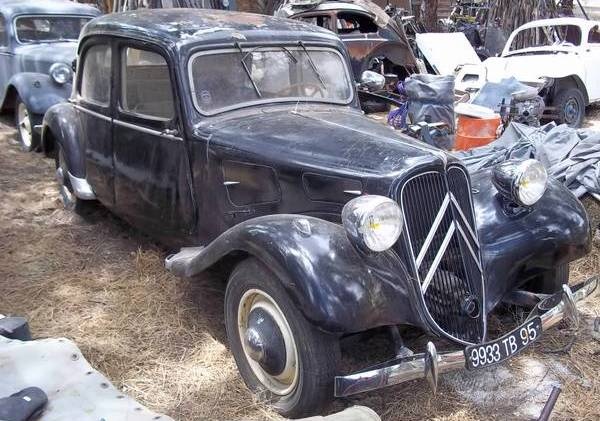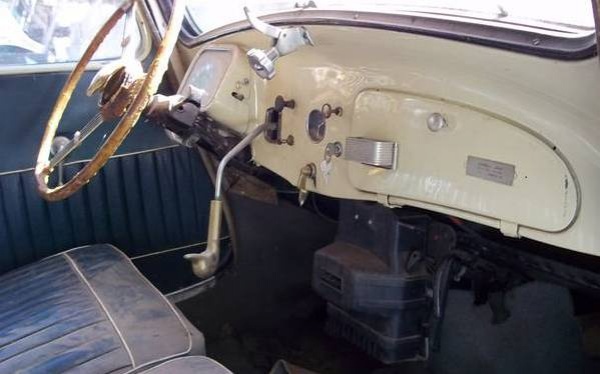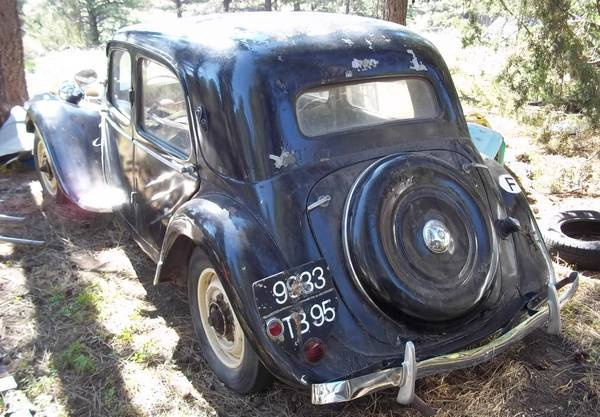
Front wheel drive and unibody construction are common features of modern automobiles, but back in the thirties they were unheard of. Consumers were nervous that unitized bodies bodies would not offer the strength provided by a frame and the idea of sending the power to the front wheels was absurd. Still, some innovators persisted. This 1937 Citroen Traction Avant was the result of one of those forward thinkers and although it may not look it, this car was packed full of cutting-edge engineering. Find it here on craigslist out of Flagstaff, Arizona. A special thank you goes to Robert J. for the tip!

The inline-four engine may not have been anything out of the ordinary, but the fact that it was driving the front wheels as early as 1934 is astonishing. Only a handful of manufacturers had even attempted it at that point, but Citroen made it work in a mass produced car. The seller of this one mentions that it “should be close to running”. We are not sure what that means, but these were complicated machines so we do not recommend it to the inexperienced.

Appointments are simple inside, but take note of the dash mounted shifter. It is attached to a three-speed aluminum transaxle that was so good that it even saw some use in Formula 1. With the transaxle mounted out in front of the engine there was no need for a transmission tunnel, so the floor is flat making the interior more spacious and comfortable. Having the engine behind the front axle also helped with weight distribution and the unit body construction kept weight down.

The exterior may date the car, but the underlying mechanicals were light years ahead of the competition. Amazingly the Traction Avant was in production from 1934 to 1957. Obviously there were improvements made over those 23 years, but that is a testament to the original design. There are very few FWD cars that we would actually like to have in our garage, but this Citroen is definitely one of them!


Here’s a closeup of the dash plaque. We assume this is the proof that the seller mentions that it was in France for a while. It would be interesting to hear more about this car’s past.
First owner, most likely.
I looked up the address and it looks like in 1937 there was probably a different building there….66 years ago.
You wonder if that original owner is still alive….
And what is behind the Citroen?
Looks like another Citroen.
And a couple of VWs.
The French license plate is also a clue, though these are easy to fake. The CL ad sets a new standard for brevity. Might as well say “give me money, haul it away”
French plates were made to order by your local autoparts store once you provided your registration documents. I have one of the plate stamping machines to make my own vanity plates.
Hard to see how this writer decided the car has 6 cyls when it only has 4! Also interesting to note that crazy pipe routed beside the valve cover – looks like someone tapped into the top rad. hose with some copper pipe in order to put a decent heater inside on the engine hump. Wonder why they just didn’t run a length of heater hose??? As designed, I’d expect to see fatigue cracks somewhere along that piping or a solder joint…….And this ad is one of two that showed up earlier trying to sell the other Traction behind this one in the photo.
You are right! Thanks for catching my error. The six-cylinder was not fitted until 1938 so this has the 1.9 liter four. I will update the post to reflect that fact.
Love the dash mounted shift lever, it makes the interior a little more unique.
These were quite ahead of their time.
Originally called model 11 B or such.
Traction avant was the ‘nick name’ that stuck, but really only means front wheel drive in french.
They must have built 100s of thousands before and after WW2….
Your french version of a suicide door gangster car….
so cool.
When I see this, I think of French gangsters fanging around the cobbled lanes of Paris. Chouette!
Nice & yes I have seen a few of these over the years but never looked inside to see the gear selector, cool.
not sure about the seller. but i sure hope someone save both the citroens. maybe the VWs for parts.
Not sure I buy the comment about the transmission being “so good”. Here’s why. It is known that Andre Citroen had his engineers burning the midnight oil to develop an automatic or semi automatic transmission for the Traction. Henry Ford sought the same for the Model A and was also unsuccessful. In Citroen’s case, they waited a little too late before giving up on the idea and consequently the 3 speed manual was a rush job and was a weak link in these cars. I bought my 54 Traction on Craigslist for substantially less than this one but it was minus the transmission. The seller had cannibalized it to get his 1938 Traction back on the road. Fortunately I have located an engine/transmission assembly from a rusted out hulk so I should be ok.
Yeah, perhaps I should have said it was big enough to fit some heavy duty innards.
Hi z1rider
The story of the automatic gear box you told is pefectly correct. Obviously the “traction” gear box is a weak part of the taction , Strangely very little has been made to improve that box all along the life of the model.
To preserve the gear box against rough use there is a lock operated by the cluch pedal which prevents to shift the gears if the cluch in not fully open.
I own a 1952 11BL named Penelope that I bought in1967 for 100 francs…
We are still together and very happy.
The heating system inside the shown Traction comes from a Renault 4L.
Originaly there was no heating system but a tube directing air through the radiator to a hole over the driver’s left foot…
The 3 speed gearbox is still the weakest part of the car – we’ve lost 3 of them in the last 2 yrs in the SF bay area. The loads on the C&P are high enough, and the case weak enough that sudden sharp stresses in the drivetrain, combined with too wide clearances on the C&P often split the case wide open, sad to say. Plus, not having synchro on 1st gear, the car needs to be shifted gently. Then again, way back in its early history, one fellow drove a Traction 4 cyl 400,000 km in something like a year or two, and set an amazing record for the car. It must’ve been a stunt supported by the factory. The best way to keep a Traction alive is either to baby the trans or convert it to an early DS19 4 speed, which is considerably more durable and can be bolted right up to the Traction engine, but with a revised shifting linkage.
I wonder if your problem is living in the SF bay area( the hills ), if the car was in my area So Fla. would the weak trans be as bad? Perhaps the fellow that drove the car 400,000 km was in a different terrain, also less traffic, so the need for quick acceleration wasn’t as much of an issue??
Amazing how far ahead of the crowd these cars were. Not sure about his price but you never get it if you don’t ask for it.
Far ahead of there time and using American technology.
From this link:
http://www.uniquecarsandparts.com.au/founding_fathers_edward_budd.htm
“Andre Citroen Collaborates With Budd
Even Citroen, perhaps the most inventive of the European motor manufacturers, were not averse to learning from the acknowledged master of production-car body building. In 1924, Andre Citroen began a period of collaboration with Budd which was to lead to the introduction of the very successful ‘Traction-Avant’ models. During the period 1929-30, Budd demonstrated his mechanical engineering foresight by producing a prototype car featuring an all-steel body and front-wheel-drive; it was this prototype which was developed by Citroen to become one of Europe’s most popular cars until it was superseded by the majestic D Series of cars.”
In Denmark this model is also known as The Gangster Car. I think it has been used as such in movies.
Paul, we’ve had enough gearbox breakages that seem to indicate that regardless of terrain, the trans has design weaknesses: My first TA was a ’54 owned by a fellow who worked at Batavia labs near Chicago. I unstuck the engine, repaired a few other things and drove it intermittently for 10 yrs around Detroit and then sold it to a fellow back in Chicago who’d been after it for quite some time. I took him on a test drive before he bought it. A week after he’d got it back, he was driving there – pretty flat land – he evidently had a tooth pop off a gear, and it went between two gears and split the case down the middle! He lost all the lube, but was able to drive the car home with it clunking over the missing tooth, but had to have the whole case heliarced back together and gears replaced. His driving technique must’ve been different from mine, or fatigue had weakened a tooth to make it ready to fail. I recenty bought a box from a friend who told me how it failed: The wheels were being balanced by having the front end on a lift, and they were being spun by the engine or an old motor and friction wheel. There must’ve been some backlash going on between the guts and the two wheels that the box didn’t like. It split crosswise in 3 places between the front cover and diff housing! Never seen anything like it, and never did figure out how the heck it happened. I still have to rebuild the box in a very nice ’57 (last yr of prod.) that lost 5 teeth off 2nd gear when the RH inner Ujoint had one shaft of the cross fall out of its needle cup, bind up the joint, and the gears couldn’t take the stress – they went instead of the tire sliding. I’ve got all the parts but will rebuild it before I sell it this fall. Moral is – treat the gearbox gently! As one technique, I always tell a prospective or unskilled Traction owner to touch 2nd gear with the shifter before moving to 1st, to slow the gears and prevent crunching – works with all sticks. In this latter case, the owner knew very little about cars – he never detected the slop developing in the inner Ujoint – was a real klutz – if he’d had any seat of pants feel for a car, he wouldv’e noticed the looseness and clacking of the joint as the clutch was released and not destroyed the box. He was still attempting to drive the car, as it still moved, with the horrible clunking he had in 1st gear! Sad thing is, several yrs prior, I had done his brakes, rewired the harness after it burned up when he left the V reg. cover loose and it grounded out on the base, and had the gas tank sealed, but I never drove the car except to test the brakes & didn’t notice then any potential problem with the Ujoint.
Well not the first or last car that has it’s share of design flaws. I owned a bunch of Alfa’s over the years & you always want to find 2nd gear before starting off in 1st. same as you mentioned for this car.
Re the “gangster car” label – this applied only to the 15-6 Tractions with the 2.8 L straight 6 cyl engine. The French gangsters used these cars as they were supposedly good for near 100 mph, and could keep going even if a rear tire was shot out by the gendarmes. Whether or not the gendarmes got the sixes to compensate is another question…….I recently sold a ’54 Traction 15-6 H to a friend in GM. It just happened to be the ex-GM test car, and had the distinction of being the only Traction I’ve ever heard of that had power front seats! Someone at GM as tall as Bob Lutz must’ve had an influence on that feature, as that added legroom was a real benefit, and it was definitely a GM/Fisher Body type of switch, even tho I bought the car from a fellow who worked at Chrysler. Come to think of it, that fellow had the car when Lutz was Pres. of Chrysler – wonder if Bob knew of it back then and had something to do with the modification? Bob does have a 15-6 in his personal collection, but my car was the very rare H model (only 1700 built), with the DS hydraulics on the rear suspension only.
Funny seeing this and reading the comments. Just last evening, I watched Barry Maguire’s Car Crazy, and he featured a visit to the Citroen plant and a tour of their archived vehicles. The history behind these cars and all the models shown was fantastic. I’ve always wanted a CV2 to play with, like the one in American Graffiti. If you get a chance, try to catch that episode of Car Crazy and see what Citroen is doing still today. LJ
If you are attracted by the technological progress of automobiles you can’t help but admire the Traction’s advanced engineering, which in so many ways was still advanced when Citroen ended production in 1957 to say nothing of how revolutionary it was at introduction in 1934. Rack and pinion steering, unit construction, independent front suspension, low CG, and other advancements are now almost universal. I can’t wait to get mine on the road.
As for the transmission, just a comment to help illuminate the previous comments about how to take care of it. The reason you would want to “touch second” prior to selecting first is that when stationary, the synchronizer for second or for that matter 3rd is as good as having a sychro on first. The job of a synchronizer is to bring the input shaft to the speed (whether up or down) that matches (through the respective gear ratio) the speed of the output shaft. The “touch second” comment works when stationary since the output shaft is stationary and so the input shaft also needs to be stationary. That applies for all gears, even reverse, so that advice will also prevent the crunch if reverse is to be selected, but again this only applies when stationary. The synchro brings the spinning input shaft and clutch disc to a halt for a clash free shift into the gear lacking a synchronizer. And of course this applies to any transmission which does not have a synchronizer on one or more gears, but of course requires a synchro on at least one of the gears. This would not work on for example a model A Ford since none of the gears are synchronized.